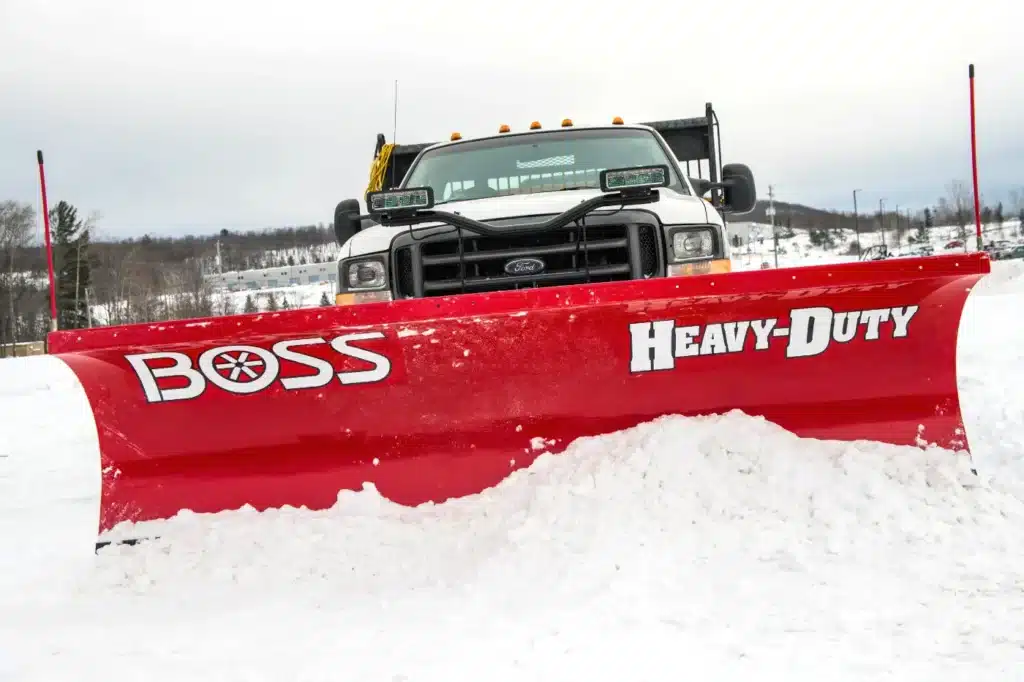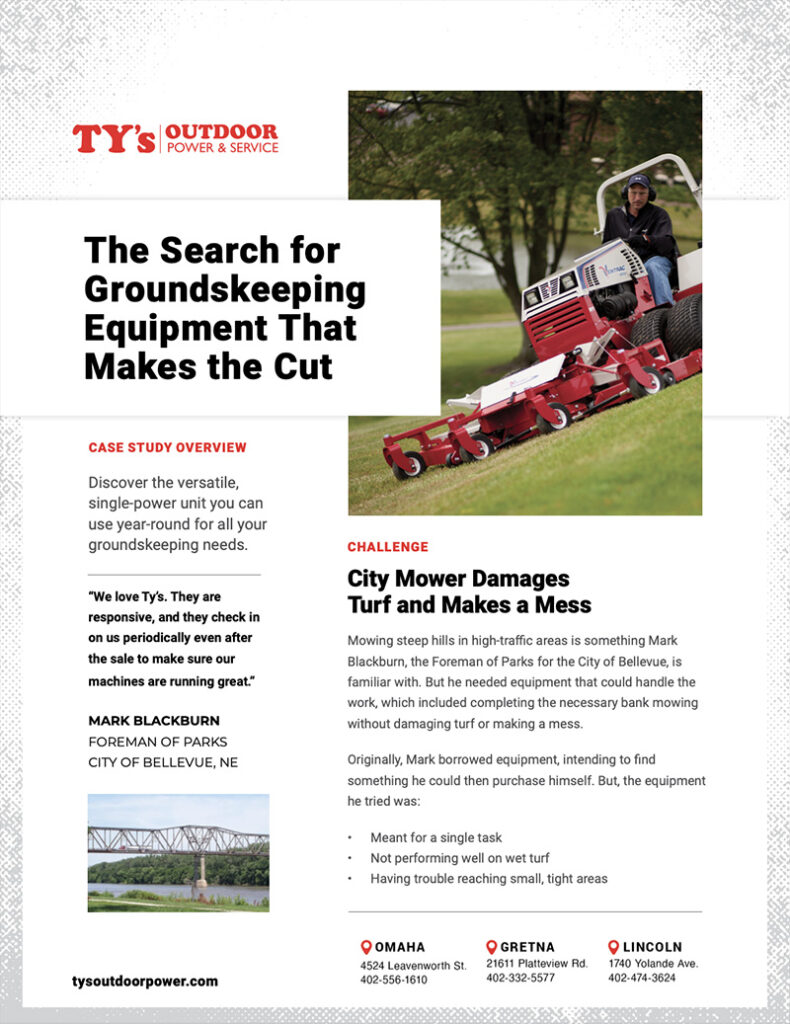Well, the lawnmowers are tucked away, the temperature is dropping, and the trees are getting pretty bare. This can only mean one thing – it’s wintertime again, and it’s time for your lawncare company to shift into snow mode.
Whether you’re just adding snow removal services to the business this year or you’re in the market for a new snow plow blade, there are some key things to keep in mind before you install any blade on your trucks. Choosing the wrong blade or failing a key installation step can cause damage to your truck, your clients’ surfaces, and your reputation.
Check out these six tips to make sure you select the right snow plow blade and mount it correctly to keep the snow moving this winter.
Fit Matters
To avoid damage to your truck, choosing a snow plow blade that fits is crucial. A well-fitted blade just works better, and it’s safer. Without considering fit, you risk damaging both your truck and the surfaces you plow.
To pick the right snow plow blade, start with your truck’s specifications. Check the truck’s manual for the recommended blade size and weight. Different trucks need different blades. Consider your driving conditions, too. If you often drive on narrow roads, a smaller blade might be best. For large areas and large trucks, a wider blade can save time.
Next, think about the type of snow you’ll face. Heavy, wet snow needs a stronger blade. Light, fluffy snow is easier to handle with a standard blade. Finally, make sure the plow can be mounted easily. This will help you switch it on and off quickly when you need to.
Watch That Weight Limit
Not all trucks are up to the task of snow plowing. Most snow plow blades are made for half-ton trucks, which usually weigh 1,500 pounds or more.
If you try to install snow removal equipment on a smaller truck, you’re creating a recipe for damage. Smaller trucks often lack the strength needed to push that additional weight. They may struggle to lift the heavy blade. This can lead to damage to your truck or the plow. It can also make the snow removal less effective.
Using a snow plow requires balance and power. Larger trucks provide both. They can push through heavy snow without issues. Unfortunately, smaller trucks don’t have the same capability. It’s important to respect the weight limit. Always check your truck’s specifications before attaching a snow plow.
If your trucks aren’t well-suited to snow plow blades, consider other solutions like the BOSS Snowrator. It’s great for walking surfaces and residential driveways. The Snowrator has a 4′ blade and can make quick work of most residential snow removal when a truck-mounted plow blade isn’t an option.
Pick the Right Plow Blade Material
In order to avoid damage to your truck or your clients’ surfaces, you want to choose a blade made out of the right material for the job. Three common types of materials are used: mild steel, stainless steel, and polyethylene. Understanding these materials helps you pick the right blade for your snow plow. Consider the weather and how often you’ll use the plow. With the right material, you can clear snow quickly and easily.
Mild Steel
Mild steel snow plow blades have both benefits and drawbacks. One major benefit is their affordability. Mild steel is less expensive than other materials, making it a popular choice for many operators. These blades are also strong and can handle tough conditions. They work well on most plow trucks.
However, mild steel has some drawbacks too. It can rust over time, especially when exposed to moisture. This can lead to damage if the blades aren’t properly maintained. Mild steel isn’t as durable as other materials like carbide or stainless steel. It may wear down faster in heavy use.
Mild steel blades are best for light to moderate snowfalls. They’re ideal for residential areas or smaller parking lots. If you have a snow plow truck for regular snow removal, these blades could be a good choice. Just remember to keep them maintained to avoid rust. Overall, mild steel might be the right option for budget-conscious operators who need reliable performance.
Stainless Steel
Stainless steel snow plow blades also have pros and cons. One major benefit is their durability. They resist rust and corrosion—hence the “stainless” part of their name. This makes them great for tough winter conditions. Stainless steel blades last longer than other materials. They can handle ice, hard-packed snow, and heavy snow without bending or breaking.
Another advantage is their smooth surface. This design helps the blade glide over the snow, reduces friction, improves efficiency, and makes plowing easier for the truck.
However, there are some drawbacks. Stainless steel blades can be more expensive which may not fit every budget. They can also be heavier than other blades, which might affect the truck’s fuel economy and limit the number of trucks that can actually support them.
Stainless steel is best for areas with heavy snowfall. It works well for cities or regions that face harsh winters. In these places, having a strong, durable blade is important. It ensures the snow will be cleared quickly and efficiently.
Overall, stainless steel snow plow blades are a smart choice for serious snow removal. They save time and effort in tough conditions.
Polyethylene
Polyethylene snow plow blades are another material option. These blades are lighter than metal blades, making them easier to handle and reducing truck wear and fuel consumption. Polyethylene also doesn’t usually scratch asphalt or concrete, which is great for people who want to keep their driveways and roads in good shape.
However, there are some drawbacks. Poly plows wear down faster than metal ones, and they may need to be replaced more often. These blades don’t cut through thick ice as effectively as metal blades can.
Polyethylene blades are best for lighter snow conditions. They work well in residential areas or places with less snow. A metal blade is a better choice if you often deal with heavy snow or ice.
Know Your Controls
You can prevent a lot of damage to your truck, plow blade, and your clients’ driveways just by choosing a plow with the right controls. Each snow plow blade has different types of controls. Some blades operate with a joystick. Others may have a simple switch. Make sure you understand how these controls work.
Before you choose a snow plow blade for your truck, check its compatibility. Your truck needs to work well with the plow, and different trucks and plows have different requirements. If the controls don’t match, it might be hard to operate the equipment.
Think about how you want to work with the snow plow. Do you prefer using a joystick or a button? Choose the setup that feels most comfortable for you. This can make plowing less stressful and make it easier to train your employees.
Level and Set the Blade at the Right Height
Now that you’ve picked a snow plow blade, it’s time to mount up.
When installing a snow plow blade on a truck, the height of installation matters—a lot. The ideal height for the blade is about 1 to 2 inches below the truck’s bumper and half an inch above the ground surface. This allows the blade to clear most snow without damaging driveways while still maintaining adequate clearance for the vehicle’s front end.
Setting the blade at the right height is important for a few reasons. First, if the blade is too high, it won’t pick up enough snow. This means snow could be left on the road, making driving dangerous for everyone. Second, if the blade is too low, it can hit the ground or uneven surfaces, bending or breaking the blade.
Make sure your blade installation is level and that the blade stays level when put down on the plowing surfaces. If your blade is unlevel, snow removal will be much less efficient, and you risk damaging both your truck and the surface you’re plowing. Both straight blades and angled blades need to be leveled at installation.
Some trucks need a leveling kit installed to achieve this. (See this article from BOSS to know when your truck might need one.)
There’s ROI on Professional Installation
Installing a snow plow blade on your trucks needs the right touch. You might think about doing it yourself to save money. However, professional installation often has a better return on investment (ROI).
First, professional installers at plow dealers have the right tools and know exactly how each plow blade should be fitted to each truck. This means fewer mistakes and no extra costs later on. If you install it yourself, you could damage your truck, leading to costly repairs, or install the blade incorrectly. An incorrectly installed blade is damage waiting to happen, and no one wants to have a plow suddenly go down in the middle of a blizzard.
Plus, hiring a professional saves time, which is valuable for all businesses. You can focus on other things while they do the heavy lifting.
In the end, paying for professional installation of a snow plow blade often pays off. You get peace of mind, quality work, and save time—a true win-win!
Let the Team at Ty’s Install Your Plow Blade
Don’t risk damaging your truck with the wrong snow plow blade. Let us help!
The expert staff at Ty’s Outdoor Power can help you find a great deal on the right equipment for your client load and budget. Whether you’re ready to install or it’s time to buy a new snow plow blade, Ty’s Outdoor Power has your back. We’ll help you choose the right blade for your truck and get it installed for you. Schedule service online to get your plow blade installed, or shop our wide range of top-quality commercial snow plow blades — ask us about financing options!


